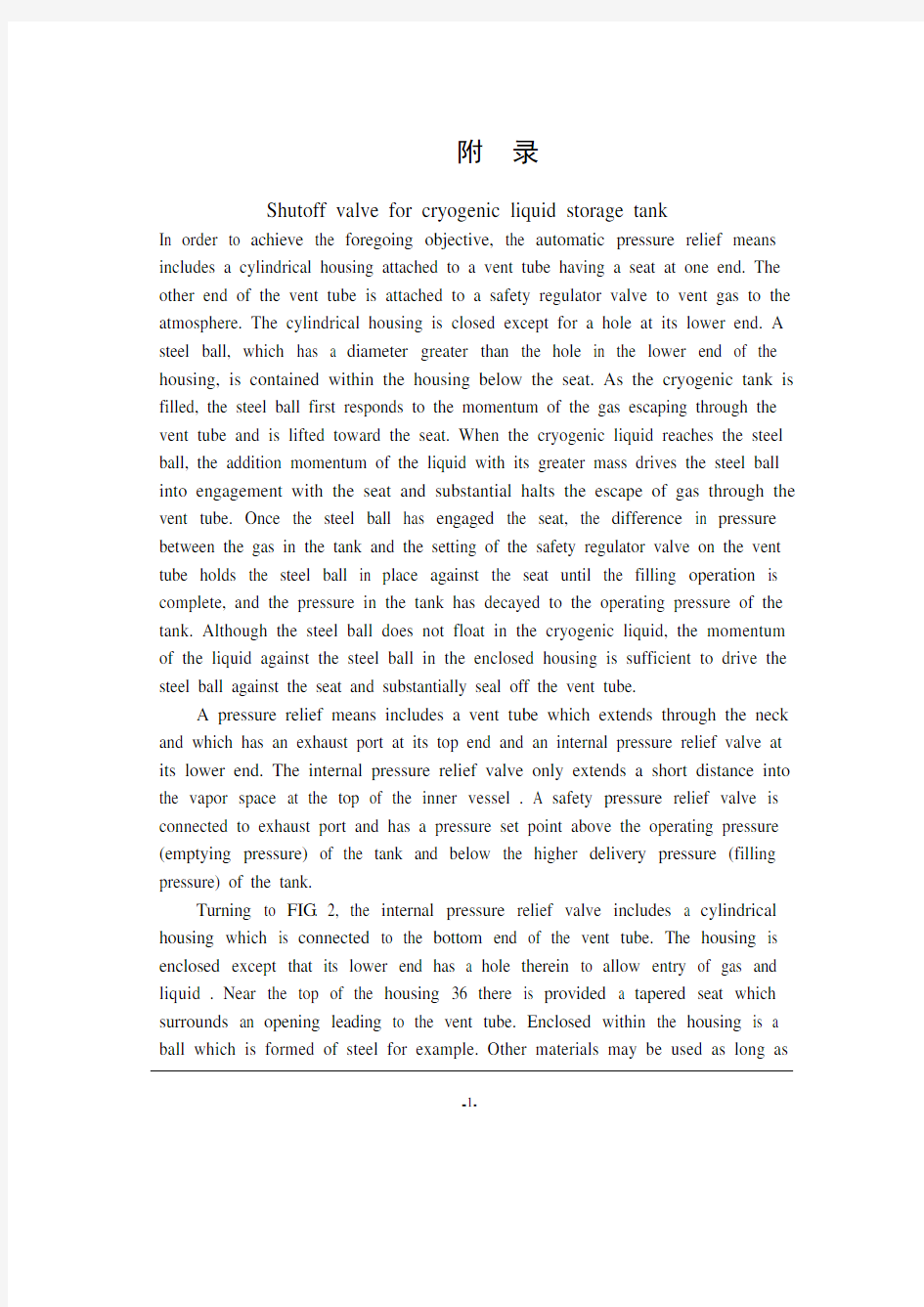外文翻译-低温液体储罐

- 1、下载文档前请自行甄别文档内容的完整性,平台不提供额外的编辑、内容补充、找答案等附加服务。
- 2、"仅部分预览"的文档,不可在线预览部分如存在完整性等问题,可反馈申请退款(可完整预览的文档不适用该条件!)。
- 3、如文档侵犯您的权益,请联系客服反馈,我们会尽快为您处理(人工客服工作时间:9:00-18:30)。
附录
Shutoff valve for cryogenic liquid storage tank
In order to achieve the foregoing objective, the automatic pressure relief means includes a cylindrical housing attached to a vent tube having a seat at one end. The other end of the vent tube is attached to a safety regulator valve to vent gas to the atmosphere. The cylindrical housing is closed except for a hole at its lower end. A steel ball, which has a diameter greater than the hole in the lower end of the housing, is contained within the housing below the seat. As the cryogenic tank is filled, the steel ball first responds to the momentum of the gas escaping through the vent tube and is lifted toward the seat. When the cryogenic liquid reaches the steel ball, the addition momentum of the liquid with its greater mass drives the steel ball into engagement with the seat and substantial halts the escape of gas through the vent tube. Once the steel ball has engaged the seat, the difference in pressure between the gas in the tank and the setting of the safety regulator valve on the vent tube holds the steel ball in place against the seat until the filling operation is complete, and the pressure in the tank has decayed to the operating pressure of the tank. Although the steel ball does not float in the cryogenic liquid, the momentum of the liquid against the steel ball in the enclosed housing is sufficient to drive the steel ball against the seat and substantially seal off the vent tube.
A pressure relief means includes a vent tube which extends through the neck and which has an exhaust port at its top end and an internal pressure relief valve at its lower end. The internal pressure relief valve only extends a short distance into the vapor space at the top of the inner vessel . A safety pressure relief valve is connected to exhaust port and has a pressure set point above the operating pressure (emptying pressure) of the tank and below the higher delivery pressure (filling pressure) of the tank.
Turning to FIG. 2, the internal pressure relief valve includes a cylindrical housing which is connected to the bottom end of the vent tube. The housing is enclosed except that its lower end has a hole therein to allow entry of gas and liquid . Near the top of the housing 36 there is provided a tapered seat which surrounds an opening leading to the vent tube. Enclosed within the housing is a ball which is formed of steel for example. Other materials may be used as long as
-1-
they have sufficiently high melting temperatures so that the ball can remain within the housing while the tank is being welding during fabrication. Materials that can withstand the heat of fabrication are too dense to float in the cryogenic liquid in the inner vessel. Consequently one cannot rely on the buoyancy of the ball to force the ball into contact with the tapered seat and close the internal pressure relief valve. I have discovered that the momentum of the cryogenic liquid flowing into the housing can be used to propel the ball into engagement with the tapered seat and substantially close the internal pressure relief valve.
In order to fill the tank (FIG. 1), a single delivery hose from a transport tank (not shown) is connected to the inlet/outlet port by means of the coupling and pipe. The vapor pressure in the transport tank causes the cryogenic liquid in the transport tank to flow through the hose, through coupling, through pipe, through pipe, and into the inner vessel. As the cryogenic fluid rises in the inner vessel, the vapor pressure increases until it exceeds the set point of safety pressure relief valve. Once the set point of safety pressure relief valve is exceeded, the vapor escapes (as shown by arrows in FIG. 2) through the internal pressure relief valve, the vent tube, the exhaust port, and the safety pressure relief valve, which has its set point below the pressure of the transport tank. Consequently, the vapor is vented to the atmosphere instead of being compressed above the liquid and creating back pressure sufficient to counteract the vapor pressure in the transport tank. As the vapor escapes through the vent tube, it necessarily passes through the hole and the housing. As the gas passes through the housing, the momentum of the escaping gas causes the steel ball to rise within the housing toward the tapered seat. The steel ball and housing are dimensioned such that the momentum of the gas is not sufficient to drive the steel ball into engagement with the tapered seat. Once the liquid rises to the opening of the enclosed housing, liquid is forced through hole and into the enclosed housing. Because the liquid has a greater mass and therefore greater momentum than the gas, the momentum of the liquid flowing into the housing is sufficient to drive the steel ball into engagement with the tapered seat.
To assure proper operation of the internal pressure relief valve, the dimensioning of the steel ball and the enclosed housing is critical. Particularly, in a preferred embodiment of the present invention in which a steel ball is used, I have found that a 1/2 inch steel ball performs satisfactorily when the inside diameter of
-2-
